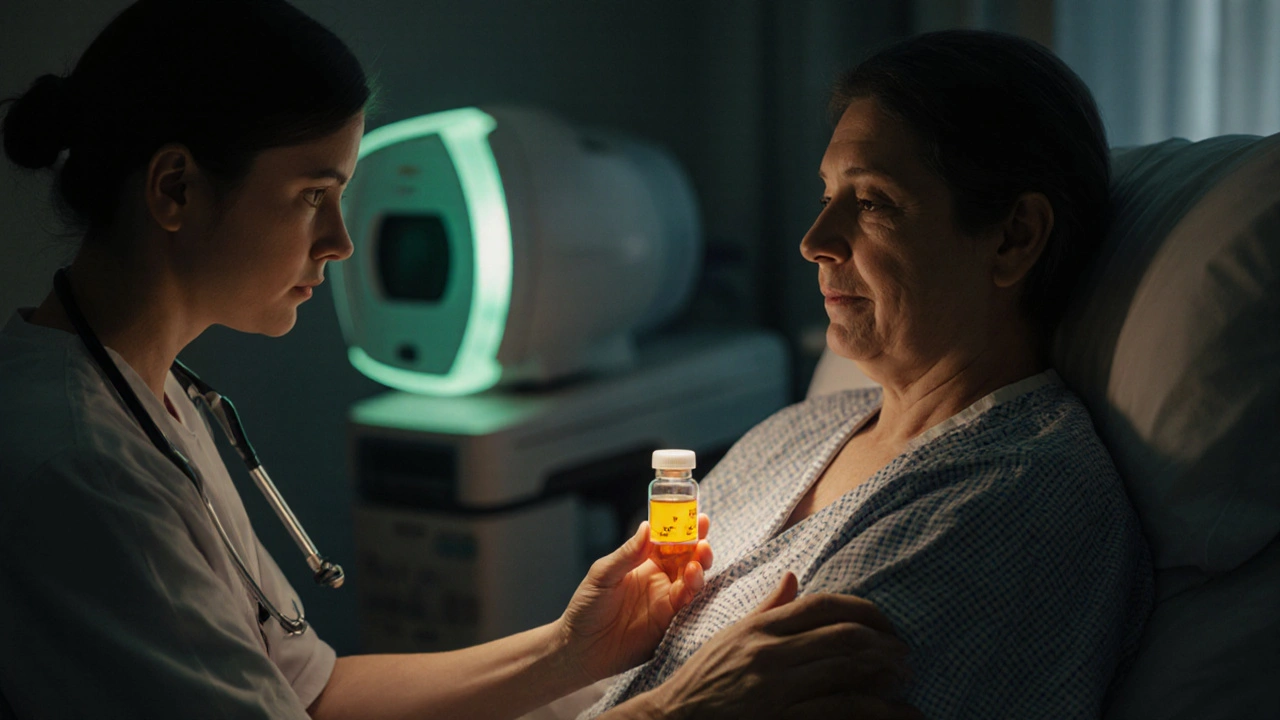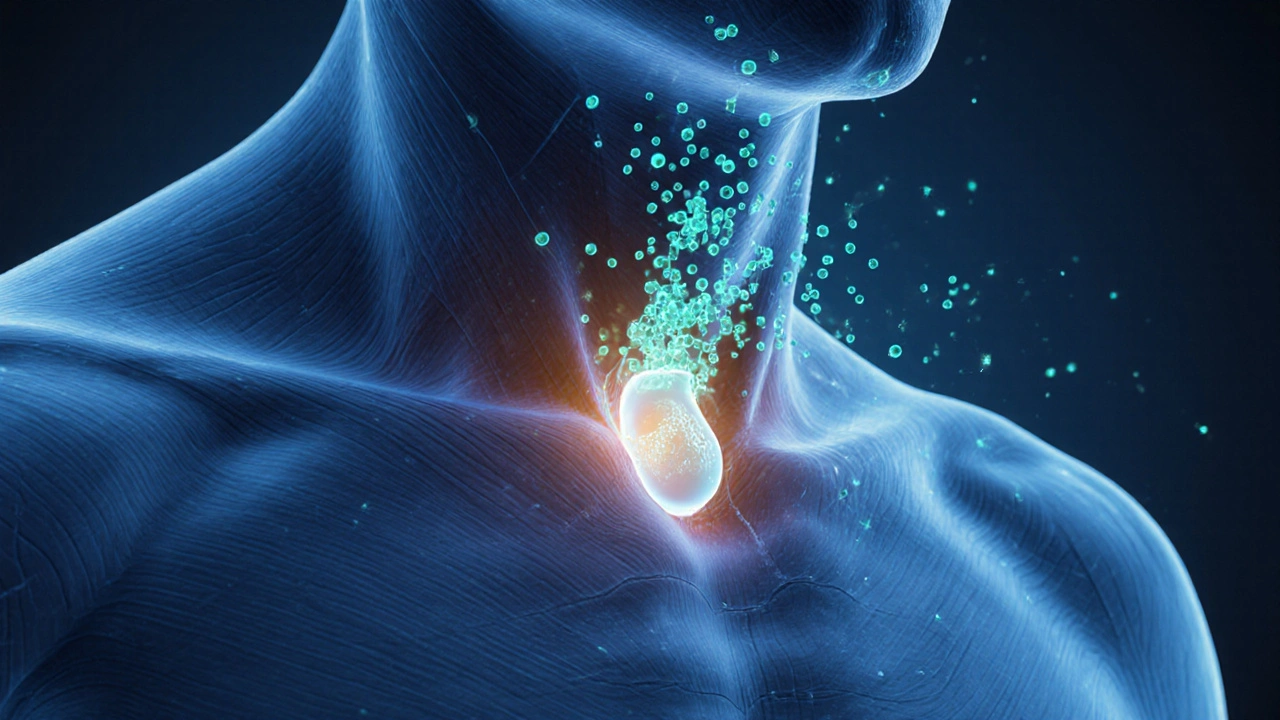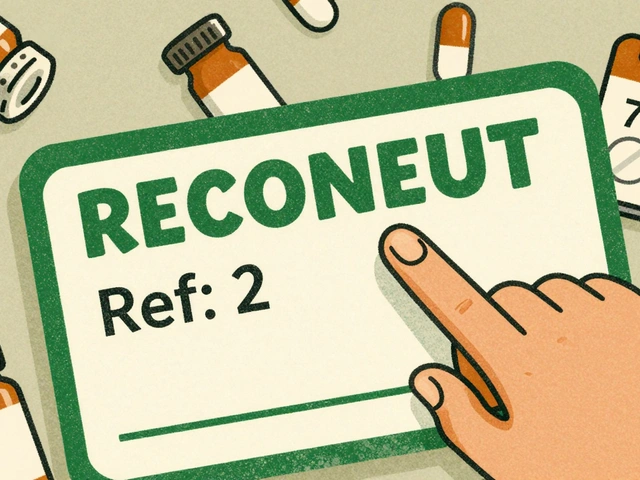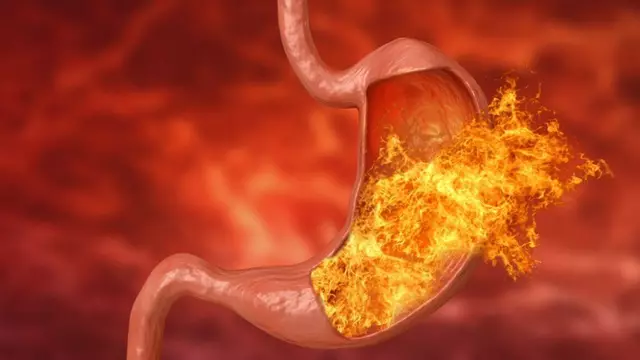RAI Treatment Timeline Calculator
Treatment Timeline Summary
Preparation Period
Treatment Day
Recovery & Follow-Up
| Side Effect | Typical Onset | Management Tips |
|---|---|---|
| Neck tenderness | 1-3 days | Warm compress, acetaminophen |
| Dry mouth | 2-5 days | Sugar-free gum, stay hydrated |
| Altered taste | 3-7 days | Soft foods, avoid strong flavors |
| Nausea | Within 24 h | Small meals, ginger tea |
| Temporary low blood counts | 2-4 weeks | Routine blood tests; usually resolves |
Quick Takeaways
- Radioactive iodine (I‑131) targets thyroid cells after thyroid cancer surgery.
- Patients must follow a low‑iodine diet and may need hormone adjustments before treatment.
- Common side effects include neck tenderness, dry mouth and temporary changes in taste.
- Most patients resume normal activities within a week, but radiation precautions last 4‑7 days.
- Long‑term monitoring involves blood tests and periodic scans to check for recurrence.
When a surgeon removes a thyroid gland because of cancer, the job isn’t finished. Tiny cancer cells can hide in the remaining tissue or spread elsewhere. That’s where radioactive iodine treatment steps in - a targeted therapy that hunts down those stray cells while sparing most of the rest of the body.
Radioactive Iodine Treatment is a medical procedure that uses the radioactive isotope Iodine‑131 to destroy thyroid tissue left after surgery. It works because thyroid cells naturally absorb iodine, and I‑131 delivers a lethal dose of radiation from inside the cell.
Thyroid Cancer is the most common endocrine malignancy, accounting for about 3% of all cancers diagnosed in the United States. The majority are differentiated types - papillary and follicular - which still retain the ability to take up iodine.
Why Iodine‑131 Is the Right Choice
Unlike external beam radiation, I‑131 travels through the bloodstream directly to thyroid cells. This internal delivery means higher doses reach the target while surrounding tissues get far less exposure.
Iodine‑131 emits both beta particles (which break DNA in cancer cells) and gamma rays (which allow doctors to image the distribution after treatment). The half‑life of I‑131 is about eight days, so the radiation fades relatively quickly, making it safe for most patients when proper precautions are followed.
Preparing for the Scan: Diet, Meds, and Timing
Preparation starts weeks before the actual dose. The goal is to deplete the body’s iodine stores so the thyroid cells grab as much I‑131 as possible.
- Low‑iodine diet: For 1‑2 weeks, avoid iodized salt, dairy, seafood, soy sauce, and certain breads. Replace them with fresh fruits, vegetables, eggs, and plain grains.
- Thyroid hormone management: After the thyroid is removed, patients usually take Levothyroxine. In the weeks before RAI, doctors may switch to a thyroid‑stimulating hormone (TSH)‑raising regimen - either by withholding levothyroxine for 3‑4 weeks or by giving recombinant TSH injections.
- Pregnancy check: Women must have a negative pregnancy test; radiation can harm a developing fetus.
- Blood work: A baseline Thyroglobulin Test is drawn to see how much thyroid protein remains. Elevated levels after surgery can signal residual tissue.
All these steps usually happen under the guidance of an endocrinologist and a Nuclear Medicine Department, which coordinates the actual dose delivery.
The Day of Treatment
On treatment day, the patient checks into the nuclear medicine suite. After a brief review of the prep checklist, a nurse places a small glass vial containing the I‑131 dose (usually 30‑150 mCi, depending on cancer stage) under the patient’s arm.
The patient then waits for a short “uptake” period - about 4‑6 hours - while the radioisotope travels through the bloodstream and settles in thyroid cells. During this time a Whole‑body Scan may be performed using a gamma camera. The images highlight any areas of abnormal iodine uptake, pointing out possible metastases in the lungs or bones.
After the scan, the patient receives discharge instructions. Because the body is still emitting radiation, a set of safety rules follows:
- Sleep alone on a separate mattress for 24‑48 hours.
- Avoid close contact with pregnant women, infants, and the elderly for about a week.
- Use separate bathroom facilities if possible; flush the toilet twice after each use.
- Wash hands frequently and keep personal items (phones, glasses) away from other household members.
What Happens Inside the Body?
Once I‑131 is taken up, beta particles travel only a few millimeters, enough to destroy thyroid cells but not surrounding tissue. The radiation induces DNA breaks, leading to cell death over the next few days. Most of the remaining radioactivity is expelled through urine, so staying well‑hydrated speeds up clearance.
Within 2‑3 weeks, the majority of the treated thyroid cells are gone. The body’s natural healing processes then replace the dead tissue with scar tissue, which does not take up iodine.

Common Side Effects and How to Handle Them
| Side Effect | Typical Onset | Management Tips |
|---|---|---|
| Neck tenderness | 1‑3 days | Warm compress, acetaminophen |
| Dry mouth | 2‑5 days | Sugar‑free gum, stay hydrated |
| Altered taste | 3‑7 days | Soft foods, avoid strong flavors |
| Nausea | Within 24h | Small meals, ginger tea |
| Temporary low blood counts | 2‑4 weeks | Routine blood tests; usually resolves |
Most side effects are mild and self‑limiting. If any symptom persists beyond two weeks or worsens, contact your endocrinologist.
Long‑Term Follow‑Up
After the radioactive dose, doctors schedule a series of check‑ups to confirm the treatment worked.
- Thyroglobulin monitoring: Every 6‑12 months, a blood test measures thyroglobulin. Undetectable levels usually mean no residual thyroid tissue.
- Diagnostic whole‑body scan: Performed 6‑12 months post‑therapy to spot any lingering iodine‑avid lesions.
- Imaging for distant disease: If the scan shows uptake outside the neck, a CT or MRI may be ordered to assess metastases.
- Hormone replacement: Most patients stay on Levothyroxine for life, often at a dose that keeps TSH slightly suppressed to reduce recurrence risk.
Researchers continue to study optimal dosing, but current guidelines (American Thyroid Association 2024) recommend the lowest effective activity that achieves complete ablation, balancing cure rates with side‑effect risk.
Special Considerations
Not every thyroid cancer patient needs RAI. Low‑risk papillary cancers confined to the thyroid (stageI) may be observed without radioactive iodine, especially if the post‑surgical thyroglobulin is already undetectable.
Patients with distant metastases that still take up iodine can benefit dramatically from higher activities (up to 200mCi) in a series of treatments, potentially turning metastatic disease into a chronic, manageable condition.
Pregnant or breastfeeding women are excluded from treatment. In rare cases of allergic reaction to the iodine carrier, alternative therapies such as external beam radiation or targeted kinase inhibitors are considered.
Putting It All Together: A Typical Patient Journey
Imagine Sarah, a 42‑year‑old teacher diagnosed with papillary thyroid cancer after a routine neck ultrasound. She undergoes total thyroidectomy, and the pathology report shows a 1.5cm tumor with microscopic lymph‑node involvement.
Her endocrinologist recommends RAI to eradicate any residual tissue. Sarah follows a low‑iodine diet for ten days, stops levothyroxine for four weeks, and gets a negative pregnancy test. On treatment day, she receives a 100mCi dose of I‑131, spends the night in a low‑radiation hotel, and follows the home‑isolation guidelines for five days.
Two weeks later, a whole‑body scan shows no abnormal uptake. Sarah’s thyroglobulin is undetectable, and she resumes levothyroxine at a dose that keeps her TSH just below the upper normal limit. Six months after treatment, a routine check‑up confirms she remains cancer‑free.
This story illustrates the typical timeline, the precautions, and the reassuring follow‑up plan that most patients experience.
Key Takeaways for You
- Radioactive iodine targets thyroid cells because they naturally absorb iodine.
- Preparation (low‑iodine diet, hormone adjustment) maximizes treatment effectiveness.
- Side effects are usually mild and resolve quickly; stay hydrated and follow the safety checklist.
- Long‑term monitoring with blood tests and scans ensures any remaining disease is caught early.
- While highly effective for many patients, RAI isn’t mandatory for low‑risk cancers - discuss the pros and cons with your doctor.
Frequently Asked Questions
How long does the radiation from I‑131 stay in my body?
The majority of I‑131 is eliminated within 5‑7 days through urine. The radioactive half‑life is 8 days, so after about two weeks the dose is low enough that normal daily activities are safe, but distance precautions are kept for 4‑7 days.
Can I work or go to school after treatment?
Yes, after the initial isolation period (usually 24‑48h) you can resume most activities. However, avoid close contact with pregnant women, infants, or the elderly for about a week.
Do I need to stay on thyroid medication forever?
Yes. After removal of the thyroid, you’ll require lifelong levothyroxine replacement. Doses are often tweaked to keep TSH slightly suppressed, which helps lower recurrence risk.
What if my scan shows iodine‑avid tumors outside the neck?
I‑131 can still treat those metastases if they absorb iodine. Higher activity doses are administered, sometimes in a series, and follow‑up scans track response.
Is radioactive iodine safe for older adults?
Safety isn’t age‑dependent; the main concern is kidney function, which helps clear the isotope. Older patients are screened for renal health before dosing.








11 comments
Ikenga Uzoamaka
I can't believe people just accept this without questioning the FDA's approval process. I mean, really? Radiation inside your body? And they tell you to eat plain rice for weeks? This is straight out of a sci-fi horror movie.
Mathias Matengu Mabuta
The premise of this article is fundamentally flawed. Iodine-131 is not a targeted therapy-it's a blunt instrument. The body does not distinguish between 'good' and 'bad' thyroid cells. You're irradiating your entire endocrine system, and then pretending it's safe because the half-life is 'only' eight days. The data on secondary malignancies post-RAI is suppressed by pharmaceutical lobbying.
Lee Lee
I've been researching this for 17 years. The government doesn't want you to know that I-131 was originally developed during the Manhattan Project. The thyroid is a bio-sensor for electromagnetic frequencies. They use this treatment to mask the real cause: 5G towers. Your body absorbs iodine because it's trying to shield your pineal gland. They don't tell you that because it would break the illusion of 'medical science.'
John Greenfield
You people are naive. The low-iodine diet? It's not about maximizing uptake-it's about making you dependent on their branded supplements. The whole system is rigged. I worked in nuclear medicine for 12 years. They over-prescribe RAI to boost hospital revenue. Your 'undetectable' thyroglobulin? That's just a number they manipulate to keep you scared and coming back.
Ashley Tucker
I'm sorry, but if you're going to let a foreign country's medical guidelines dictate your treatment, you deserve what you get. We used to treat thyroid cancer with surgery and observation in America. Now? We're just another branch of the German pharmaceutical empire. Wake up.
Allen Jones
I just got my RAI treatment last week... and I swear, my cat hasn't looked me in the eye since. 😢 I think it knows. I'm radioactive now. Like a walking Chernobyl. I keep my phone in a lead box. My wife sleeps in the garage. I cried watching my daughter hug her grandma. She's 3. I'm not supposed to touch her for 7 days. 🤕💔
jackie cote
Stay hydrated. Take your meds. Follow the guidelines. This treatment saves lives. You're not alone. Your endocrinologist is your ally. This isn't a conspiracy-it's science. You got this.
ANDREA SCIACCA
I was diagnosed at 28. They told me I'd be on levothyroxine for life. I refused. I went on a 40-day water fast. I drank seawater. I chanted mantras. I meditated with Himalayan salt. I'm now cancer-free. No meds. No radiation. Just pure spiritual alignment. The system wants you weak. Don't let them win. 🌿✨
Camille Mavibas
I did RAI last year. Dry mouth was the worst 😣 but sugar-free gum saved me. Also, the whole 'sleep alone' thing was kinda lonely. But I'm cancer-free now 🙌 and I get to eat sushi again! 🍣❤️
Dr. Alistair D.B. Cook
The article claims that I-131 is 'safe' because it has an eight-day half-life. This is a gross misrepresentation. The biological half-life of iodine in the body is influenced by renal function, thyroid remnant mass, and hydration status. Moreover, the cumulative stochastic risk of thyroid cancer in offspring of treated individuals is not adequately addressed in current guidelines. The ATA 2024 recommendations are not evidence-based-they are consensus-driven, and consensus is not proof. The data on secondary malignancies remains underreported in the SEER database due to coding inaccuracies. This is not medicine. It is risk management disguised as cure.
Shubham Singh
I read this whole thing and I still don't know if I should trust it. I'm from India and we don't have access to this kind of care. My cousin got treated with herbs and prayer. She's alive. Maybe the real cure is not in the lab but in the soul? I don't know anymore.